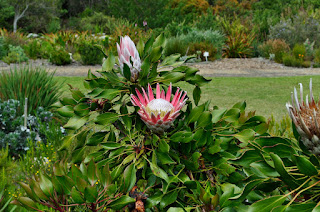The APGA, or American
Public Gardens Association, is an organization whose vision is “a world
where public gardens are indispensable.” The Botanic Gardens at Kona Kai is a
member of APGA since they are “committed to increasing the knowledge of public
garden professionals throughout North America and internationally through
information sharing, professional development, networking, public awareness,
and research so they have the tools to effectively serve visitors and members.”
In essence, they are here to help us better serve you!
After attending my first APGA conference in Minneapolis, MN,
I was delighted by how friendly and welcoming everyone was. People who work with
plants run the gamut of sociability and this group was very gregarious. I was
also surprised to see speakers from many gardens I had already been to or
recognized. Public gardens range in size from thousands of acres to barely two acres;
from large, research institutions like the New York Botanic Garden to small
gardens such as ours; from having conservation
collections of rare plants from around the world to native plants particular to
that region and everything in between. There are botanic gardens literally
everywhere! I have been fortunate enough to have visited many gardens
throughout my years of travel (see lists below) but have so many more to visit
that it will take me years. I had better stay away from a BGCI (Botanic Garden
Conservation International) meeting or I will be flying around the world for
the rest of my life; there are 144 gardens in Australia alone!
Next year’s APGA conference will be in Miami and we are
hoping to promote our idea of a "Transforming Your Understanding of Plants" (TYUP™) garden tour to other garden
administrators. Every garden should have a tour focusing on the current and
historic uses of plants and on modern plant science and technology as public
gardens are charged with educating the public about Why Plants Matter™. Our lives on this planet are fundamentally linked to plants: the oxygen they produce, the ecosystems they have created which provide us food, shelter, and clean water, the medicines they provide, and the new perspectives on evolution and technology they provide. Points like this are not usually offered on a standard botanic garden tour as we take them for granted. At our garden, we combine these stories of the importance of plants with their beauty and histories for a more comprehensive understanding of their richness and our dependence on them.
Gardens are easy to visit, near many metro areas or tourist
destinations, and usually require only about a 2-hour stroll for a quick
survey or guided tour. For those who enjoy excitement and crowds, festival weekends at large
gardens provide a glimpse into the local culture and are a fun way to see a
garden come alive. And of course, booking a guided tour is a great way to learn
about the plants and the history of a garden.
Below are lists of gardens I have visited with photos I've taken at a few of my favorite gardens, and a wish
list of gardens to visit in the future. Of course, if my travels take me
anywhere near an interesting botanic garden, I make sure to visit. Any
additional suggestions are welcome!
NATIONAL GARDENS
Desert Botanical Garden in Phoenix, Balboa Park Botanical
Building in San Diego, Huntington Botanical Gardens, Santa Barbara Botanic
Garden, University of California at Santa Cruz Arboretum, San Francisco
Botanical Garden, Japanese Tea Garden & Conservatory of Flowers in Golden
Gate Park, UC Botanical Garden at Berkeley, Tilden
Regional Parks Botanic Garden, Ruth Bancroft Garden, Luther Burbank Home and
Gardens, Portland Japanese Garden, Maui Nui Botanical Gardens, University of Minnesota Landscape Arboretum,
Como Park Zoo & Conservatory, Chicago Botanic Garden, University of
Michigan Matthaei Botanical Gardens & Nichols Arboretum (my old stomping grounds during college), Montreal Botanical
Garden, New York Botanical Garden, The High Line, Atlanta Botanical Garden,
Vizcaya Museum & Gardens, John C. Gifford Arboretum, The Kampong National
Tropical Botanical Garden, Fairchild Tropical Botanic Garden, Montgomery
Botanical Center, Pinecrest Gardens, Block Botanic Garden, Naples Botanical
Garden, USF Botanical Gardens, Bok Tower Gardens, and
Birmingham Botanical Gardens
Walnut Creek, California
Santa Cruz, California
INTERNATIONAL GARDENS
Leon Levy Native Plant Preserve – Bahamas
Kirstenbosch National Botanical Garden – South Africa*
Harold Porter National Botanical Garden – South Africa*
Parc Botanique et Zoologique Tsimbazaza – Madagascar
Hong Kong Zoological and Botanical Gardens
* South Africa has an amazing
commitment to botany with their network of nine unique National Botanical
Gardens scattered throughout the country.
Betty's Bay, South Africa
Cape Town, South Africa
WISH LIST
Missouri Botanical Garden
Royal Botanic Gardens at Kew & Edinburgh
Quarryhill Botanical Garden
Jardín
Etnobotánico de Oaxaca
Marie Selby Botanical Gardens
Coastal Georgia Botanical Gardens at the Historic Bamboo Farm
The Polly Hill Arboretum - recommended by my tour guests
Harry P. Leu Gardens - recommended by my tour guests
Emily B. Magnaghi
Associate Director




















































